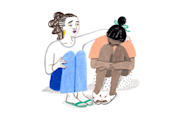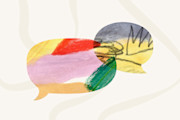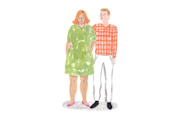What's my relationship attachment style?
And, what are attachment styles, anyway?
Your attachment style affects all your relationships—from romantic to platonic.
It's no wonder that Americans' Google searches for "attachment styles" have seen a dramatic increase since 2019. Many people are also searching for attachment style tests, like this one.
Whether you crave intimacy or you ghost when someone gets too close, your interpersonal behavior is likely due to the very first relationships you ever had—with your parents or caretakers.
That being said, early challenges are not a sentence to suffer.
While their symptoms can continue into adulthood, attachment disorders are generally diagnosed in children.
Your attachment style isn’t a diagnosis.
As an adult, understanding your attachment style is a tool in your arsenal of ways to understand yourself and to have healthy, positive relationships. To help with this consider connecting with a licensed therapist specializing in couples counseling and/or therapists with expertise in attachment-based issues.

Read on to learn about attachment theory, the four attachment styles, and how to find out your attachment style.
What's attachment theory?
The theory of attachment was originally created by British psychiatrist Dr. John Bowlby, M.D. Bowlby presented his theory to the British Psychoanalytic Society in London in three now-classic papers: “The Nature of the Child’s Tie to His Mother” (1958), “Separation Anxiety” (1959), and “Grief and Mourning in Infancy and Early Childhood” (1960).
Bowlby defined attachment as "the affectional bond that infants form with their mothers," in 1969's Attachment and Loss, Vol 1.
According to Bowlby's attachment theory, children who felt safe with their parents and early caregivers would be more likely to develop secure attachment styles and stronger self-esteem during their lives.
In contrast, children who had more erratic early experiences with parents and caregivers, would likely struggle to form healthy, secure attachments later in life.
What are the 4 attachment styles?
Bowlby's attachment theory was further developed into the four attachment styles in the mid-1960s by American-Canadian developmental psychologist Dr. Mary Ainsworth, Ph.D.
In 1965, Ainsworth devised the "Strange Situation Procedure" as a way of evaluating one-year-old infants' attachment behavior by assessing their reactions under stress.
After studying the reaction of 56 infants, Ainsworth reported her key results in 1970 in the journal Child Development and later in 1979's Patterns of Attachment.
Ainsworth's study identified three main attachment styles
Secure
Insecure avoidant
Insecure ambivalent/resistant
According to Ainsworth, these attachment styles were the result of the infants' early interactions with their mothers.
In 1986, psychologist Dr. Mary Main, Ph.D, and clinical psychologist Dr. Judith Solomon, Ph.D., discovered and identified a fourth attachment style known as insecure disorganized.
Today the 4 attachment styles are
Secure
Avoidant (also referred to as Dismissive)
Anxious (also referred to as Preoccupied)
Disorganized (also referred to as Fearful-Avoidant)
We'll discuss each style in more detail below.
1. Secure attachment style
The secure attachment style is considered to be the most well-adjusted among the four.
According to a foundational attachment study from 1987, more than half of adults (56%) identified themselves as having secure attachment styles.
Those with a secure attachment style depend on their partners for support and emotional intimacy, without becoming codependent nor experiencing backlash and discomfort because of an overly-clingy level of closeness.
Of course, people with a secure attachment style may still sometimes feel jealous, insecure, angry, or cold in their relationships.
However, negative feelings like these are more likely to be situational in the moment and less likely to persist over time and across relationships.
2. Avoidant/dismissive attachment style
Those with avoidant attachment style and/or avoidant personality disorder (AVPD) are likely to keep partners and potential partners at an arm's length.
Even those they want to be close with may say they come across as cold or aloof, and they can have trouble opening up or being honest and vulnerable.
It’s estimated that about 25% of adults identify as having an avoidant/dismissive attachment style and between 1.5 and 2.5% of the population has AVPD.
An avoidant/dismissive attachment style may result from emotionally distant caregivers, or a lack of consistent caregiver support.
Those with avoidant/dismissive attachment styles may have commitment issues and tend to push people away to avoid feeling smothered.
Living with an avoidant attachment style
If you think you may have an avoidant/dismissive attachment style, and you’d like to change the way you act in relationships—you can.
By building trust with your partner, you can learn that leaning into emotional intimacy doesn’t inherently result in feeling suffocated.
If you’re single, you can still work on shoring up your self-esteem, and practicing safe emotional intimacy in other areas of your life.
Focus on building friendships and familial relationships that are secure and fulfilling, as a way of unlearning the idea that getting too close means feeling trapped.

3. Anxious/preoccupied attachment style
Those with an anxious/preoccupied attachment style are likely to enter relationships quickly and with intensity, rapidly becoming attuned to their partners’ likes, dislikes, and interests—often to the detriment of their own selfhood.
Around 19% of adults identified themselves as anxious-preoccupied in relationships.
Those with attributes of an anxious-preoccupied attachment style are more likely to exhibit characteristics of a codependent in relationships, leading to power imbalances and feelings of worthlessness.
An anxious-preoccupied attachment style may result from caregivers who were inconsistent in their parenting style.
One moment the parent is loving and caring and the next, the parent is inattentive leading to insecurity in their relationships.
Living with an anxious-preoccupied attachment style
It can be challenging for those with anxious-preoccupied attachment styles to change the way they engage in relationships.
At times, the impulse to work for change can be stifled by feelings of low self-worth.
Remember that you deserve a relationship that makes you feel just as fulfilled and uplifted as you strive to make your partner feel.
You can work to become more independent in your relationship and communicate this need to your partner so they can support you.
If you’re single and believe you have harmful attributes of anxious-preoccupied attachment, consider taking a break from dating to focus on you.
Your relationship with yourself is essential, and figuring out your boundaries and needs will benefit you in the long run, regardless of your relationship status.

4. Disorganized/fearful-avoidant attachment style
The disorganized attachment style can be particularly challenging, because it involves attributes of both avoidant/dismissive and anxious-preoccupied attachment.
A 2019 study suggests that 10-15% of people have a disorganized/fearful-avoidant attachment style. (Fearful-avoidant/disorganized attachment was not included in the 1987 research, because it had only just been discovered at the time by Main and Solomon).
Living with a disorganized/fearful-avoidant attachment style
From an outside perspective, people with a disorganized/fearful-avoidant attachment style can seem “hot and cold.”
They may come across as highly inconsistent, showering partners with love and even neediness at one moment and withdrawing the next.
People with this attachment style often had childhoods characterized by unreliable caretaking and resources.
Their caregivers themselves may have been unpredictable, leading to feelings of abandonment and unresolved fear.
Disorganized attachment attributes can make relationships especially challenging.
Those looking to heal from the trauma that causes disorganized/fearful-avoidant attachment can benefit from comprehensive treatment to help cope with triggers, and develop a secure and safe sense of self.
Insecure attachment and trauma
If you’ve experienced trauma, the consequences likely extend beyond your relationships.
Often, those who have been through trauma feel its shockwaves in all areas of life.
If this sounds like you, consider what you need to address all the ways your experiences affect you.
Traumatic childhood experiences are, sadly, relatively common.
The experiences that cause insecure attachment can run the gamut from a messy divorce, to the loss of a parent or guardian, to witnessing or enduring emotional or physical abuse.
You may also have attributes of insecure attachment without having had what you might consider a serious traumatic experience. Ultimately, measuring trauma by its “seriousness” while you’re trying to heal is often a futile exercise resulting in self-judgement.
If you’re hurt, you’re hurt—and you deserve space and time to heal.

Find out your attachment style
Take our 3-Minute Attachment Style Quiz to find out your personal attachment style, and you'll get a free customized report.
Knowing your attachment style is helpful to developing a better understanding of your interactions and behavior in relationships. Results are completely confidential.
Working with your attachment style
It's important to understand that many people have attributes of insecure attachment styles.
After all, no matter how hard parents may try, virtually no one has a perfect upbringing.
As you learn more about your attachment style, you can also consider the attachment styles of your romantic partners.
Some styles may pair better than others, and understanding how someone you love thinks and feels is always a pathway to more fulfilling and productive communication.
Ultimately, we are all the product of both our experiences and our decisions.
When it comes to attachment styles, remember that you’re not destined to only a certain kind of relationship, just because of your early childhood experiences.
If the attributes of an insecure attachment style are negatively affecting your relationships, you can work with a licensed counselor or therapist to help develop new, healthier habits.
How to get help with relationship and attachment issues
Seeking professional help is often beneficial to learn coping mechanisms and develop or strengthen relationships of all kinds.
If you’re having a challenging time with relationship issues, consider talking with a therapist who specializes in couples counseling and/or therapists with expertise in attachment-based issues.

With a network of over 100,000 counselors, the Monarch Directory by SimplePractice makes it easy to find therapists and marriage counselors who accept your insurance.
READ NEXT: How to tell Your Partner You Want to Go to Couples Counseling
Need to find a therapist near you? Check out the Monarch Directory by SimplePractice to find licensed mental health therapists with availability and online booking.









